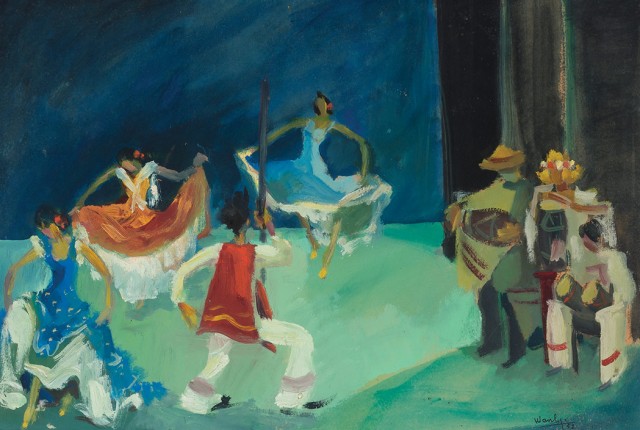Middle Eastern Modern
05/02/2017 Modern & Contemporary Art

In the May 10, 2017 sale of Post-War & Contemporary Art, Doyle continues to examine the global impact of American and European Modernism with the inclusion of many notable Modern painters from the Middle East. What is most fascinating about these artists is their ability to draw influence from the revolutionary 20th century movements from the west, yet still retain influences of their own land. This reinterpretation of western Modernism through the eyes of gifted artists from locations like Egypt, Iran and Lebanon offer new perspectives on painting as Modern Art expands across the globe.
Adham Wanly
Born in Alexandria, Egypt, Adham Wanly (1908-1959) studied with Italian painter Ottorino Bicchi (1878-1949), who had studied at the Academy in Florence. Bicchi introduced Wanly and his brother Seif to outdoor painting as well as capturing light, colors, and shades of nature. After establishing a studio with his brother in Alexandria in 1935, Wanly traveled regularly to Europe where he was inspired by landscapes, ballet, opera, and theatrical performances. He also regularly published satirical drawings in Egyptian newspapers. In 1957, the Wanly brothers began teaching at the Faculty of Fine Arts in Alexandria. Wanly’s early works were influenced by Bicchi, who had looked to French impressionism and the École de Barbizon. Later, his work exhibited fauvist and cubist trends. His passion for the performance arts can be seen in the vibrant and dynamic movements of his paintings.
Avni Arbas
Avni Arbas was born in Istanbul (1919-2003) and was encouraged to pursue artistic endeavors by his military father at an early age. He was taught by Ibrahim Çalli, an established Turkish painter, at the Istanbul Academy of Fine Arts under Leopold Levy. He received a scholarship by the French government to study in Paris. When called upon to return to Turkey for military service, Arbas would not leave his artwork, which in turn stripped him of his Turkish citizenship. Arbas looked to Picasso and the traditions of Post-Impressonism and Symbolism. He was part of the “Yeniler Grubu” or The Newcomers Group while in Turkey. Also known as the Harbor Painters because of their first exhibition showing harbor scenes, the Newcomers aimed to portray Turkish social realities using formal strategies pioneered by Western modernity, including impressionism, fauvism, and cubism. Arbas is often known for his paintings of daily life in Turkey, the Turkish War of Independence, and nature.
Louay Kayali
Syrian artist Louay Kayali (1934-1978) first exhibited his paintings at his high school in Aleppo. At age twenty-two, he went on to study at the Academy of Fine Arts in Rome from 1956-1961. While exhibiting his works at various art fairs, Kayali also taught fine art at Damascus University and the Higher Institute of Fine Arts in the early 1960s. A few years later, Kayali began to undergo a psychological crisis and his paintings began to represent the torture and struggle of man. In 1967, he made his seventh showing at the Damascus Arab Cultural Center, where his work was attacked with criticism. At the end of the exhibition, he destroyed his paintings and later left teaching. Kayali was known to paint nature and village landscapes, but is perhaps most well-known for his paintings of everyday people, often giving a statement of resistance.
Saliba Douaihy
Saliba Douaihy was born in northern Lebanon and his early works were inspired by the surroundings of his hometown, Ehden. Douaihy apprenticed in Beirut for two years and in 1932 traveled to Paris where he studied oil and fresco painting at the École des Beaux-Arts. He returned to Lebanon and established a successful studio before immigrating to New York City in 1950. Acquaintances Mark Rothko and Ad Reinhardt exposed Douaihy to abstract expressionism and subsequently he eschewed from his academic training. Inspired by Immanuel Kant’s philosophies, Douaihy sought the sublime in his paintings and strove to reduce compositions to their most basic forms. Douaihy’s flat, minimalist paintings were further inspired by the works of Josef Albers and throughout the 1960s he was collected by The Museum of Modern Art and The Guggenheim, among other notable institutions.
Hossein Kazemi
Iranian artist Hossein Kazemi is perhaps best known for his abstract compositions of flowers and stones however, he began his career painting naturalistic, figural works. Kazemi studied at the École des Beaux-Arts in 1953 and while in Paris he was exposed to the works of his Western contemporaries. Kazemi’s art fused influences from Persian miniatures, ceramic tiles and illuminated manuscripts with a modern style. He returned to figurative painting in 1961 but had abandoned his prior naturalistic tendencies in favor of a more abstract modernism.
Ibrahim Hussein
Ibrahim Hussein coined the term “printage” to describe his unique method of combining print and collage. The Malaysian artist was blinded in his right eye as a young child but nonetheless enjoyed a long and prolific career. Hussein studied art in Singapore and London and forged acquaintances with collectors who provided him with art supplies. During a 1969 protest, he was nearly arrested for painting political commentary on a Malaysian flag and he continued to produce both politically charged and decorative works throughout his career. The following year, Hussein became the first Malaysian artist to show at the Venice Biennale and after the exposure he experienced international exposure. Hussein established the Ibrahim Hussein Museum and Cultural Foundation as a resource to aid struggling artists, as he had been assisted by those more fortunate earlier in his career.
-- Contributed by Leigh Kendrick and Megan Marie Mastrobattista